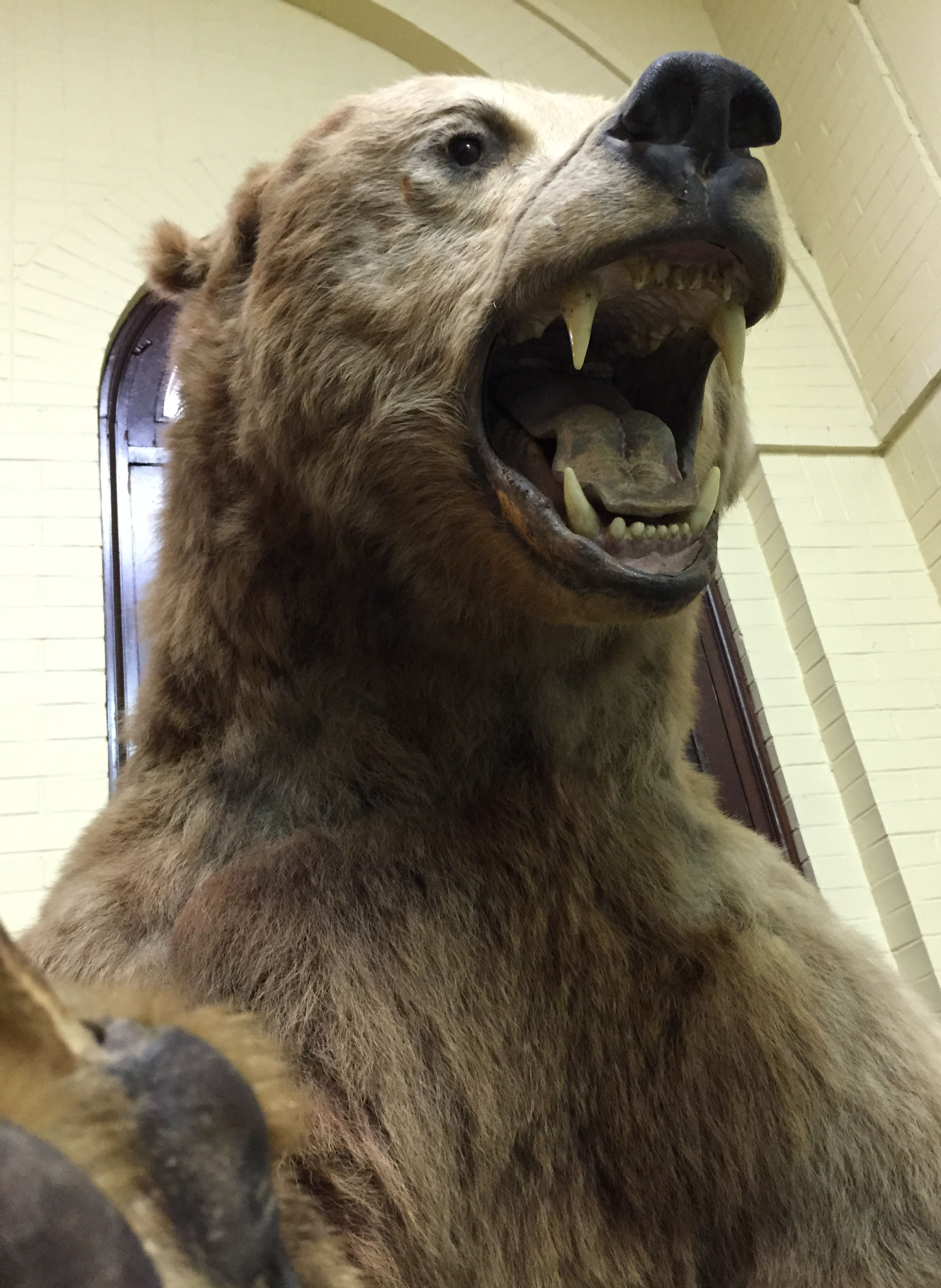Museum Landmarks
Polar Bear

Its scientific name is Thalarctos maritimus, meaning “sea bear”. Polar bears have hollow hair that is actually clear – it only appears white. Sometimes the coat can look yellowish to greenish white if algae grows inside the hairs.
The skin of the polar bear is the same color as its nose (black), which also helps to absorb heat and keep him warm. They can weigh 600-1,100 pounds and live 30 years in captivity.
Polar bears live in very cold places. Their hollow hairs trap the heat so that they can stay warm.
Short Facts
- Polar bears usually have home ranges that are just a couple hundred kilometers. However, one bear was tracked going 4,796 km (2,980 mi)! That would be like walking from Maine to Arizona!
- For short distances, polar bears can run as fast as a horse.
- To conserve energy, polar bears use a strategy called "still hunting". Instead of chasing prey, they patiently wait for a sela to come out of the water to breathe.
Teacher's Corner
Ask your children or students questions such as:
- Where in the world do polar bears live?
- What do they eat?
- What is the color of their hair?
- How does their hair and skin color help them stay warm in the winter?
Brown Bear

Brown bears are large mammals that live in cool mountain forests, meadows, and river valleys. These solitary bears are found in North America, Europe, and Asia.
Grizzly bears are a type of large brown bear found in the interior of North America. Although they sleep in dens (caves, hollow logs, or holes they dig) during the winter, brown bears are not true hibernators and can be easily awakened.
Brown bears are up to 7 feet (2.1 m) long and weigh up to 1,500 pounds (680 kg). Their thick fur ranges in color from black to brown to reddish brown to blond. Newborns weigh only about 1 pound (0.45 kg), the size of a rat.
Brown bears are omnivores who eat plants, roots, berries, fungi, fish, small mammals, and large insects.
Short Facts
- Did you know that there are places in Southeastern Alaska where you can find brown bear populations as dense as one bear per square mile?
- This practically constitutes overcrowding from the bears’ standpoint;
- On Alaska’s North Slope, brown bear densities drop to around 1 bear per 100 square miles, giving the big grizzlies room to roam;
- Biologists attribute the extremes in bear densities to the richer food supply along temperate coasts, where bears feed heavily on berries and salmon;
- Alaska has more than 98 percent of the U.S. population of brown bears. Biologists estimate there are about 30,000 of these big bruins in Alaska;
- Bears are typically solitary creatures and usually avoid the company of other bears.
Teacher’s Corner
Ask your children or students questions such as:
- What is the mainstay of a bear’s diet?
- Which other animals you know are hibernators?
Allosaurus

**Located in the lobby of Howe-Russell Hall**
Allosaurus was a predator that walked on two powerful legs, had a strong, S-shaped neck, and had vertebrae that were different from those of other dinosaurs (hence its name).
It had a massive tail, a bulky body, and heavy bones. Its arms were short and had three-fingered hands with sharp claws that were up to 6 inches long. It was up to 38 feet long and 16.5 feet tall. It weighed about 1400 kg. It had a 3 feet long skull with two short brow-horns and bony knobs and ridges above its eyes and on the top of the head. It had large, powerful jaws with long, sharp, serrated teeth 2 to 4 inches long.
Allosaurus was the biggest, most abundant meat-eater during the late Jurassic period in North America, about 154 to 144 million years ago. It may have hunted in group, ambushing even the very large sauropods. It probably also preyed upon large, plant-eating dinosaurs, like stegosaurs and iguanodonts.
In resin (as opposed to rocky fossil material) the cast skull can give a better sense of the lightness of the bony original. The Allosaurus skull appears to have been so delicately constructed, with so many gracefully connected elements, that it seems to have had an unusual propensity for disarticulating during fossilization. Yet for all its lightness, the animal’s remarkably large head was suited to a massive job: parceling prey up into 100-pound bites. Rather like the jaws of a modern snake, the jaws of Allosaurus could expand laterally around large portions of its victim. A flexible joint midway along the lower jaw allowed the bite to be far larger than otherwise possible. The allosaurus’ serrated teeth, while much smaller than those of the Tyrannosaurus rex, were just as capable of tearing free large quantities of meat.
Short Facts
- Its intelligence (as measured by its relative brain to body weight, or EQ) was high among the dinosaurs.
- Allosaurus was a huge carnivore, equipped with sharp, pointed teeth in large, powerful jaws and long, sharp clawed hands.
- Allosaurus walked on two muscular legs, its leg length was about 1.38 m; its stride length (distance between footprints) was about 2.72 m.
- Allosaurus’ femur (thigh bone) was about 30 inches (77 cm) long. There are still some discussions on whether or not the massive theropods could run very fast or not. Its skull is the most remarkable of all allosaur features. It is an arched and airy feature more reminiscent of a Gothic cathedral than the ponderous armament of an alligator or other living reptilian predator.
Teacher’s Corner
Ask your children or students questions such as:
- How do you call a person who studies fossils?
Was Allosaurus a carnivore, an omnivore, or a herbivore?